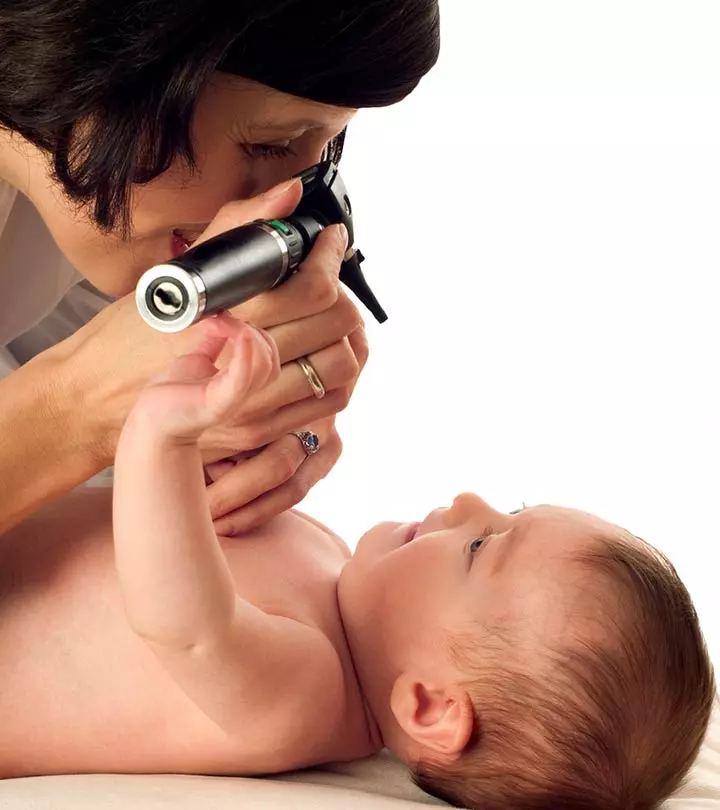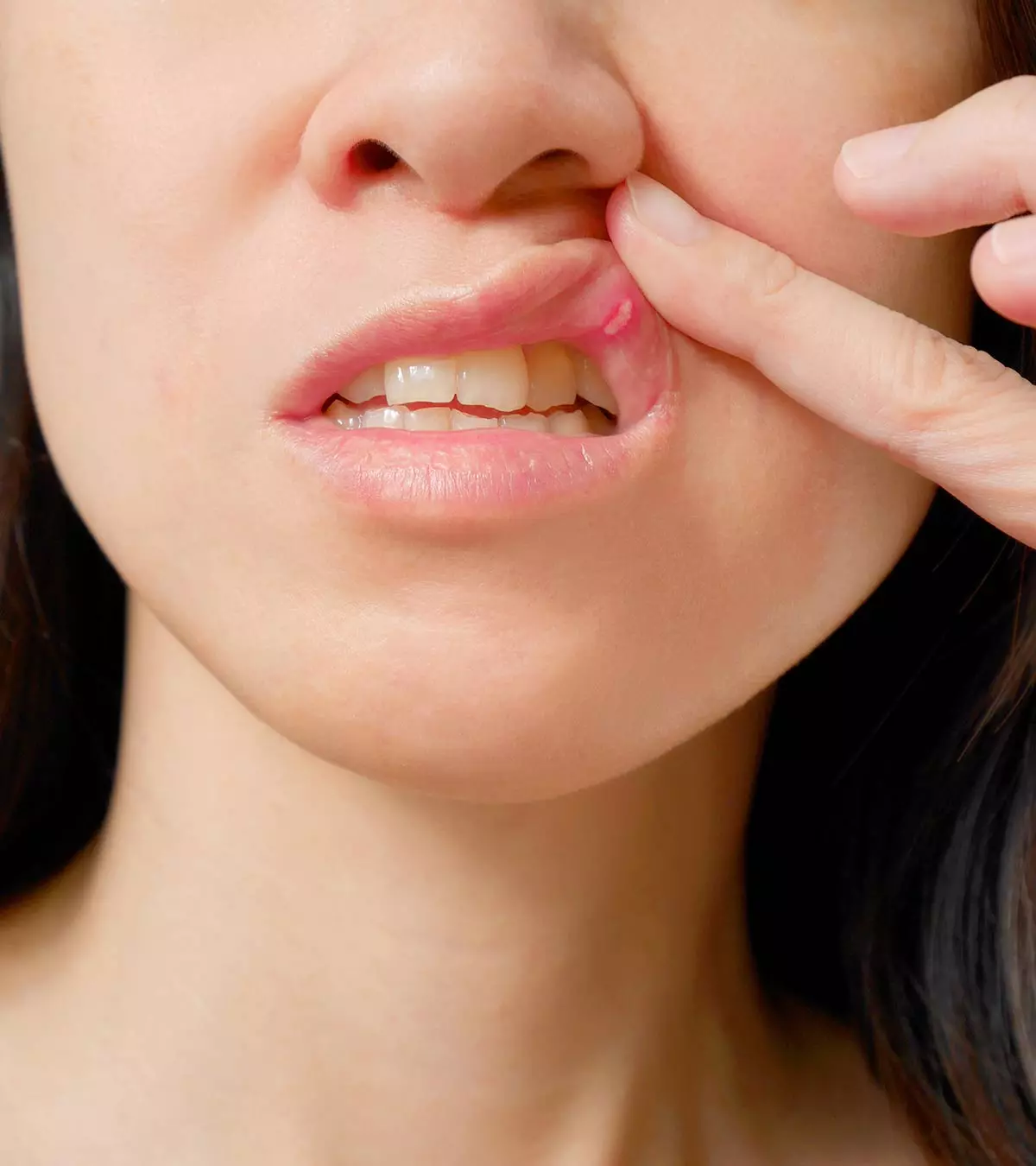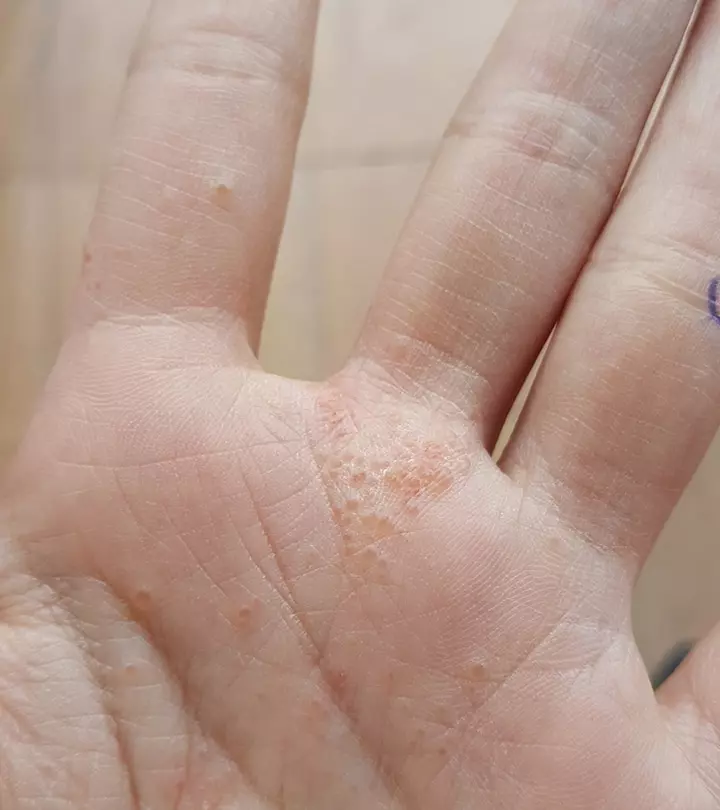
Image: iStock
It can be challenging for parents, especially new ones, to teach babies to chew food. However, your infant will need to master the chewing process, also known as mastication, to eat solid food.

Because saliva contains enzymes that break down the starches in our diet, chewing is the first stage in the digestion process. Chewing aids in breaking down the food into smaller fragments and exercises and strengthens the jaw muscles.
Teeth are required for adequate chewing, and the emergence of an infant’s teeth significantly impacts their chewing abilities. Therefore, parents should start helping their babies develop their chewing abilities at a young age.
Read on to learn when babies start chewing food, how to train them to chew, and how to detect any problems with their chewing skills.
Key Pointers
- The ability to chew properly develops around 12 months of age, corresponding with the development of the baby’s primary first molars.
- Chewing is a skill that develops over time depending on the baby’s age, extrusion and gag response, practice, and teething.
- Babies can learn basic chewing movements without teeth by consuming soft, pureed food.
- Teach your toddler to chew their food for longer and eat with their mouth closed.
When Can A Baby Start Chewing Food?

The ability to chew correctly usually appears around the age of 12 months (1). The baby would gradually become adept at chewing by 18 months of age. The 12 to 18 months phase is usually when the baby’s primary first molars (chewing teeth) erupt (2). Thus, the improvement in chewing skills coincides with the eruption of both the primary first molars.
You might likely have already seen your baby experiment with chewing with fingers or teethers around six months of age (3). During the beginner’s phase, your baby tries to coordinate the movements of the tongue, cheeks, and jaws that play an essential role in the chewing process (4).
Around six to eight months, they start chewing soft solid foods. This is the phase when parents are advised to introduce new food items into the baby’s diet gradually. By the time the baby is 12 months, they can eat food items that are less softer than the food items they ate at a younger age.
Like any other milestone, a few babies may experience a delay in developing chewing skills, which is nothing to be worried about.
Chewing Skill Development In Babies
Chewing is not an overnight process. It is a progressive skill with several other skills and events leading to it. The following are the various factors that could influence a baby’s ability to chew.
- Age: A baby develops the ability to swallow solid food after the age of six months (5). Therefore, chewing can develop only when the baby can swallow solids.
- Extrusion reflex: The extrusion reflex or tongue thrust reflex in babies is a natural reflex that causes the baby to regurgitate any solid food placed on their tongue. It prevents accidental choking due to solids. Babies lose this reflex by the age of six months (6). It is one of the first steps to the development of chewing.
- Gag reflex: The gag reflex is similar to the extrusion reflex and protects the baby from choking due to the ingestion of solids. The reflex is triggered when a piece of solid food is placed at the back of the tongue, causing the baby to expel the food to the front of the mouth (7). This baby gagging reflex fades away after the age of six months.
- Practice: Chewing can be done even without teeth. Hence, when you introduce your baby to soft and pureed baby foods after six months, it still involves a bit of chewing. It allows the baby to have adequate practice before they develop teeth. Each type of food requires the usage of different mouthparts. You may gradually increase the firmness of the food you offer to the baby based on their acceptance level.
- Teething: Teething is essential for chewing since it is only with teeth that a baby can break firm food into smaller pieces and masticate correctly. By the time babies develop teeth, they would have been well-acquainted with the basics of chewing.
 Quick fact
Quick fact
Can Babies Chew Food Without Teeth?
Yes, babies can chew soft and pureed food even without teeth. However, food is mostly chewed by the lower and upper first molar teeth that emerge by 18 months of age. Until then, babies can learn basic chewing movements, which are further advanced by the time of eruption of teeth.
What If You Don’t See The Baby Chewing?
Babies have tiny mouths, which makes it difficult for us to notice their chewing pattern. Thus, it is likely you may have missed those subtle and almost-invisible chewing movements. The next time your baby eats, observe their mouth movements closely. If you still find no chewing movements, you may want to give your baby some more time. Each baby is unique and could develop the skill at their own pace.
Why Is Chewing Food A Problem For Some Toddlers?

Babies attain the ability to chew in their toddlerhood. A toddler must go through their own learning curve to improve chewing. However, sometimes, a few toddlers could have a delay in their ability to chew.
- Lack of interest in food: Similar meals or affinity towards easy-to-chew foods may affect babies’ and toddlers’ interest in particular foods.
Sharing her two-year-old’s dietary preferences, blogger, who goes by the name ‘Happiest Ladies,’ says, “At the age of two, he knows to chew and eat cookies, wheat dosa, and urad dosa topped with honey. But his tummy fillers are still the porridge… There are no signs of quitting porridge completely from his daily diet any soon. He chews only four to five bites of dosa, that too when it is topped with any of the sweeteners. He also enjoys a few tiny mouths full of curd rice when made colorful with grated carrots and pomegranate seeds. But four to five bites or a couple of spoons of food do not satisfy a baby’s hunger. It is also a poor diet for the child. So, I follow his usual healthy porridge diet (i).” - Delayed baby food introduction: A baby must be introduced to various forms and textures of solid foods by the time they turn 12 months old. The lack of parental experimentation in feeding solids could cause the little one to become disinterested in consuming solid foods, thus causing them to swallow food than chew it first (8).
- Dental and orofacial problems: Toddlers with dental issues and orofacial problems, such as a cleft lip, and/or palate, could find chewing a difficult and strenuous process (9). Identifying the problem and providing appropriate treatment in such cases could help improve the toddler’s chewing ability.
If your toddler does not show any signs of chewing over a period of time, consult a pediatrician to determine any underlying cause, if any.
Tips To Encourage A Baby To Chew

Chewing is a natural ability that a baby will pick up eventually. Nevertheless, parents can try out the following ways to help stimulate, exercise, and improve a baby’s or toddler’s chewing skills, especially when introducing solid foods through baby-led weaning.
1. Use teethers
Babies who have experimented with chewing before may do well with chewing food. Teethers could lay the groundwork for a baby’s chewing process. Try giving your baby a teether and encourage its usage if they reject it initially. Pick soft rubber teethers free of flavors and parts that may break (10). Also, avoid teethers containing liquids, phthalates, or BPA.
2. Try baby led-led weaning
Baby-led weaning, the practice of introducing solids by skipping purees, allows your child to explore different textures, encourages chewing naturally, and promotes self-feeding. Introduce soft finger foods that they can grasp and chew at their own pace.
3. Help them practice on large pieces of food
If your baby does not prefer teethers, you can use large pieces of food as natural alternatives. Carrots and celery make great natural teethers. Make sure you cut the vegetables into large pieces, which the baby cannot swallow. If your baby already has their teeth, especially the front incisors, avoid this method since it may cause the baby to swallow a piece of the vegetable accidentally.
4. Demonstrate chewing
You can make your baby sit next to you while you eat. Try demonstrating chewing to them, even before they do it. Babies learn through observation and tend to mimic their parents.
5. Brush their gums and teeth
You can brush their teeth with a baby toothbrush and a small smear of children’s toothpaste. In edentulous babies, gauze with filtered water should be used for gum massage. Brushing a baby’s teeth helps desensitize the mouth to the gag reflex and keeps the teeth healthy.
6. Serve foods of different textures and flavors
Serve your baby foods of different textures after they attain the age of eight months. It will stimulate the chewing process and make the little one move their mouth in the manner best suited to chew a specific food item. You can initially start with finger foods or crispy foods that soften when put into the mouth, such as puffed rice, graham crackers, and boiled vegetables for babies.
7. Check for reflexes
The extrusion and gag reflexes fade away by the age of six months. They may persist for some more time in a few babies. You can observe the presence of these reflexes periodically so that you can serve relevant solid food items accordingly.
8. Start small
Each new food item or meal is a new experience for a baby. Thus, do not worry about how much your baby is eating. Instead, focus on feeding small portions of a food item to make the baby accept the food while also exercising their chewing skills, which can be beneficial for their overall infant feeding development.
9. Be patient
If your baby doesn’t like a particular food, do not give up. Try again a few days later. Also, introduce one new food item at a time so that the baby can grow used to its taste and texture.
10. Let them eat on their own

If your baby loves mimicking parents while eating, let them sit next to you during your meals. It can encourage the baby to pick food in their hands and chew it willingly. A baby with a self-driven interest in food might have an easier time learning to chew.
11. Feed them at fixed timings
A baby whose tummy is full is quite likely to swallow food without chewing when forced to eat by a caregiver. Therefore, offer food to the baby at fixed timings each day so that the little one is hungry when it is time to eat food. A hungry baby is more likely to display interest in chewing new food items.
12. Try a fruit feeder
A fruit feeder consists of a mesh bag that locks fruit pieces inside it. The baby can chew the fruit and suck its juices. Since the fruit is inside a mesh bag, it wouldn’t fall out. Do remember to purchase only an FDA-approved feeder.
 Quick tip
Quick tipThings To Do While The Baby Learns To Chew
Once a baby becomes better at chewing, parents are introduced to a new set of challenges. Here are a few things to teach the baby while they improve their chewing skills.
- Teach them to eat with their mouth closed. The sooner babies learn to eat with their mouths closed, the lesser challenges you will face in the future. Demonstrate to them how to eat with the mouth closed.
- Teach them to chew longer. Chewing marks the beginning of digestion. Hence, teach your babies to hold on to food a little bit longer.
- Provide positive reinforcement. Encourage the baby with positive words when they do things right with chewing. Acknowledge their successful attempts. Keep changing the texture of food for the toddler to better practice chewing.
Frequently Asked Questions
1. Why do babies act like they are chewing gum?
Babies sometimes appear to be mimicking the act of chewing gum because they are engaging in a reflex called the “sucking reflex.” This reflex is present at birth and helps babies to find and latch onto their mother’s breast or a bottle to feed. It also promotes oral-motor development, which will be important for them to learn to eat solid foods later on. Additionally, some babies may use this reflex as a soothing mechanism to calm themselves.
2. Is a baby chewing on nothing a sign of autism?
Chewing is an important part of the process of learning to eat solid food. A baby chewing with nothing in his mouth is normal as it could arise from instinctive behavior or an attempt to soothe himself under stress. There is no proven connection between tongue chewing and autism (13).
3. Is it normal for babies to chew on their tongues?
Babies often suck and chew on their tongues as they explore their mouths with them. This is a normal phase of their development as they learn about their bodies and the sensation of different textures in their mouths. However, if your baby is chewing the tongue excessively or seems to be getting distressed, it is important to contact their pediatrician to rule out any underlying issues.
It is important to teach your baby to chew food as chewing helps integrate saliva into the food and, in turn, aids in the proper digestion and smooth working of a baby’s digestive system. However, every child is different, and they need their own time to learn and adapt to new things and habits. Therefore, it is advised that you give your child time and have patience while they learn how to chew their food. You can give them teethers and foods of different textures and flavors to encourage them to chew. This is a trial and error process, and you will eventually be able to figure out what works best for your baby.
Infographic: Prevention Of Choking When The Baby Begins To Chew
Babies may be at an increased risk of choking on food when they have not fully developed chewing and swallowing skills. Therefore, it becomes essential to note specific things, as this infographic details, to prevent choking in babies when they begin eating solids and chewing foods.
Some thing wrong with infographic shortcode. please verify shortcode syntax
Illustration: Tips To Encourage And Teach Baby To Chew Their Food

Image: Stable Diffusion/MomJunction Design Team
Looking to make your toddler an adventurous eater? Unlock the secrets in this user-friendly video, showcasing easy techniques to transform mealtime into an enjoyable experience for both you and your little one.
Personal Experience: Source
MomJunction articles include first-hand experiences to provide you with better insights through real-life narratives. Here are the sources of personal accounts referenced in this article.
i. Reader query: my baby does not like to chew food;https://happiestladies.blogspot.com/2014/11/reader-query-my-baby-does-not-like-to.html
References
1. Jordan R. Green et al., Development of Chewing in Children From 12 to 48 Months: Longitudinal Study of EMG Patterns; NCBI
2. Eruption Charts; American Dental Association
3. Digestive System: Mouth and Stomach; LibreTexts
4. Developing chewing and swallowing skills; Ministry of Health New Zealand
5. Don’t Feed Your Baby Solid Food Before 6 Months; Cleveland Clinic
6. When Can My Baby Start Eating Solid Foods?; Rady Children’s Hospital-San Diego
7. Development of Infant Feeding Skills; USDA
8. L. Hollis et al., Age at introduction of solid foods and feeding difficulties in childhood: findings from the Southampton Women’s Survey; British Journal of Nutrition
9. Ana Bheatriz Marangoni Montes et al., Occlusal, chewing, and tasting characteristics associated with orofacial dysfunctions; NCBI
10. Teething; American Dental Association
11. Oral Reflexes and Feeding; Sensory Solutions
12. Chewing practice; The Royal Children’s Hospital, Melbourne
13. Does needing to chew mean my child has autism or sensory processing disorder?; ARK Therapeutic
Community Experiences
Join the conversation and become a part of our nurturing community! Share your stories, experiences, and insights to connect with fellow parents.
Read full bio of Dr. Shaon Mitra
Read full bio of Swati Patwal
Read full bio of Rohit Garoo
Read full bio of Ghazia Shah
















